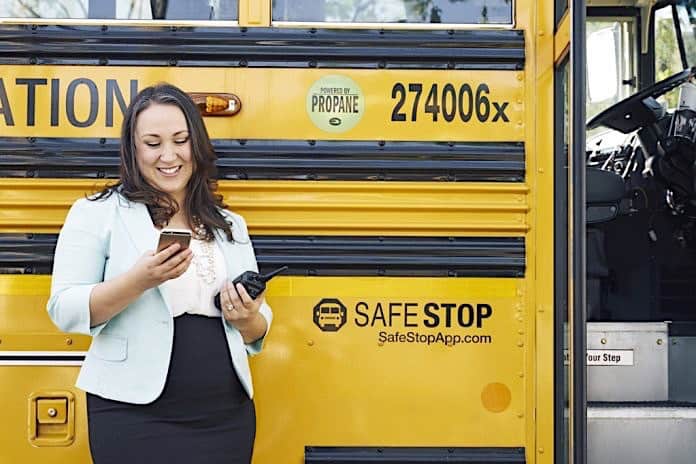Los Angeles conjures images of beaches, endless sun and celebrities. Yet even with all the glitz and glam, conversations about the city eventually settle upon one thing: The nightmarish traffic that plagues the local freeways and roads.
Pamela Hopson, director of operations at Campbell Hall, a small, exclusive private school that serves approximately 1,120 students in North Hollywood, knows the problem of Los Angeles traffic all too well.
“Traffic surrounding our campus can be unpredictable and difficult to navigate. Inherently, transportation is a hot button issue in Los Angeles and for our families as well,” she said.
School buses are crucial to reducing traffic congestion. According to the American School Bus Council, one school bus carrying students to and from school can mean 36 fewer vehicles driven by parents are necessary. This equates to an estimated 17.3 million cars removed from the nation’s roads each year during the school commute.
But even with school buses relieving some of the congestion, they are not immune to the volatility of traffic conditions, especially in places where high traffic is the norm, where, for whatever reason, smooth-flowing traffic can grind to a halt.
Such is the case in many areas throughout Los Angeles, and in the neighborhood surrounding Campbell Hall. So the school turned to SafeStop, a real-time fleet-tracking app that has made a world of difference in instantly communicating with parents and students when unpredictable situations arise and delay bus arrival times.
“We used to get lots of calls from parents asking when the bus was arriving or if they had missed the bus at their stop because they were running late. SafeStop has all but eliminated these issues for our families and our office,” said Hopson.
The SafeStop app, launched in 2013, allows parents, school staff and administrators to track school bus location in real-time and to monitor estimated arrival times. Transportation staff can also use the app to send instant alerts and messages to parents.
Scott Allen, vice president of operations at TransPar, a school transportation management and consulting company based in Missouri, said he likes the fact that SafeStop also allows transportation professionals to analyze the efficiency of the routes.
“By utilizing SafeStop Analytics, we can compare the planned route with the actual route as the bus is moving, and look at actual GPS coordinates and times,” he said. “We can match up and see if the routing is in sync and make sure the drivers are following the routes too.”
Jeffrey Simmons, transportation supervisor at the Downingtown Area School District near Philadelphia also shared this view.
“The ability to see in SafeStop the time the bus was at the scheduled stop, along with the times from the routing software, has provided the transportation office with an easier way to compare scheduled times and actual times when there are calls or concerns on a particular bus route, and make adjustments to routes if necessary,” he said.
Allen also said that a feature he especially finds convenient for Ladue School District, a TransPar school district customer located near St. Louis, is the fact that SafeStop can be integrated with various routing software.
“We use different routing software, different GPS and transportation providers for each client, and what excited us about SafeStop is its ability to work with all of these and with districts that operate their own fleet,” he said.
According to Hopson, one of the main factors that made Campbell Hall choose SafeStop over other apps is the user-friendly design and interface.
“We specifically wanted something very simple and user-friendly for families who are busy and don’t have time to navigate a clunky app or website. We love the map view that a parent can glance at quickly to determine in real time where the bus may be located,” she said.
The Rise of School Bus Apps
In a recent survey of transportation directors by STN, 20 percent of respondents of indicated that they are currently using a school bus tracking app, but twice that number noted that they are interested in learning more about them.
Of those that are using them, many said that one benefit is saving time for transportation departments in both monitoring arrival times and also communicating with parents. Both Hopson and Allen agreed that having an app like SafeStop in use has greatly reduced the time transportation staff previously spent fielding parent calls about bus location.
“It has eliminated all of the guesswork for our parents in regards to bus schedules, and we never get calls about bus timing in our offices. Plus, it not only empowers parents to know where their kids are on their route to or from school, it provides our office with precious time to devote to other initiatives,” said Hopson.
Allen said that the Ladue School District has been using SafeStop for just a few months but added that he anticipates parent calls about bus location will also decrease as more and more register to use the app. “We’re anticipating that being a good point as well,” he said.
A common concern for school districts in adding new technology is cost, however, as they often are operating with limited budgets. With SafeStop, school districts have options. They can either cover all the upfront costs and offer the technology to parents free of charge, or they can subsidize it via ongoing, monthly fees paid by parents.
In Allen’s case, he said TransPar took care of the installation costs, while parents also pay to register.
“The districts can, if they want, cover that cost, or if they want to pass that cost on to the parent. It’s pretty reasonable,” he said.
Overall, Allen said that he has been “impressed” with SafeStop and that the company has been receptive when he or his team have questions.
But student transporters are not the only ones who are responding positively to the app.
“For the most part, all of our calls or comments have been positive and parents appreciate the comfort of knowing that they can see where their child is along a bus route and when the bus is expected at their specific bus stop,” said Simmons.
















